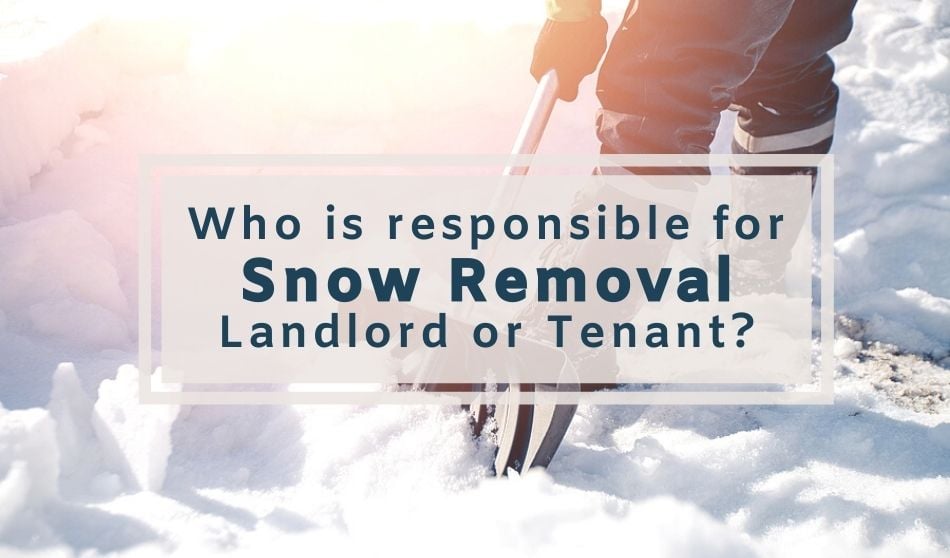
With the cold seasons just around the corner, and snowstorms on the docket already in some parts of the nation, property owners need to have a plan in place for snow season. In fact, all residents that live in a snow zone need to have a snow plan well before the first flake falls.
If you own or manage a rental property you may be wondering who is responsible for snow removal – landlord or tenant?
I hate to break it to you, but the answer is almost as annoying as having to drag yourself out of a cozy bed to start shoveling.
When it comes to landlord vs. tenant snow removal, the answer is … it depends! (Hah, figured it was going to be something vague like that).
Here’s the scoop on snow removal for rental properties.
Depending where you live, your city may or may not have a local ordinance about snow shoveling requirements. Typically, if you own a house (or business) that borders a public walkway or sidewalk, the owner is charged with keeping the sidewalk clear of snow and ice. These rules give time frames for when snow needs to be cleared and failure to comply will result in a fine.
Often, the time frame is within 24 to 48 hours after the snow has stopped falling. State and municipal laws may also include language about snow removal that includes de-icing procedures like putting salt or sand down after you shovel.
Additionally, when shoveling snow from the sidewalk, it needs to be stored on private property, not simply dumped on the road which is considered public property. Patricia Stell, the city recorder of Bend, OR explains to the Bend Bulletin, “The sidewalk and street is considered a public right of way, and a homeowner can’t dump snow back on the right of way. That means the snow has to be stored on your private property.”
Other snow removal laws can be even more confusing for a property owner, where the owner holds zero liability until he actually moves the snow and then he becomes liable if an accident occurs as the result of snow removal. See this example of snow removal at an apartment complex in Arkansas.
You should also check with local laws regarding parking restrictions on snowy days.
A Landlord’s Responsibility for Snow Removal
While landlords of single-family rental properties can specify in the rental agreement that snow removal as the tenant’s responsibility in most states and provinces, multi-family rental properties often have common walkways that the landlord must maintain, and liability is a real concern.
If you own or manage a multi-unit property, the best course of action is to take on snow removal yourself or hire a service. If you own a single-family rental property, you can include snow removal in your lease agreement as the tenant’s responsibility. When you create the tenant-landlord agreement, it’s important to be clear about when and where the snow needs to be shoveled. For example, you should specify how soon after a snowfall a path needs to be cleared and how wide the path needs to be.
Keep your resident updated on the local laws regarding snow disposal and offer safety tips to reduce the risk of injury while they do it. To ensure regular shoveling of the property, you might want to provide your tenant with a shovel and the salt or sand needed to prevent anyone from slipping on your property post-shoveling.
If you are a renter here’s what you should do when it comes to snow season – Check your lease! The lease should expressly state who is responsible for snow removal. Your landlord should be familiar with the local laws about time frames for shoveling snow. If you are lucky, a super nice landlord may state in the lease that they will come shovel the sidewalks for you! Your landlord or property manager may also have rules in place that prevent snow removal because that could make the property owner liable if an accident occurs. Now is the time to check in with your landlord or property manager so you know what to do before a snowstorm hits.
Snow Removal in Your Lease Agreements
Proper wording on the lease agreement can help eliminate a lot of confusion on who is responsible for snow removal. The lease agreement should reflect the state or municipal laws on snow removal and clearly define any details concerning time and so forth. If your lease agreement doesn’t include language about snow removal responsibilities, create an addendum that expressly discusses it and make sure both of you sign it. Make sure to have your lease agreement reviewed with an attorney who is familiar with landlord-tenant laws and snow removal requirements in your area.
Learn more about snow removal laws in your state:
The Complete Guide to Snow Removal Laws by State
This article has been updated and was originally published on November 17, 2016






Can you help me find out more info. I live in Southern Delaware in a development without a community association. The builder owns( rents about half) When we have snow we are stuck. He never comes and plows our road. It is a development of 13 single family homes with no street sidewalks. Only a road in. In 2010 we have a back to back blizzard he only came because I called him. I was stuck for 4 days. If he owns half why is he not responsible to provide snow removal?
It also looks like Delaware has a snow removal reimbursement program that you might be able to qualify for. Here’s a website with more information and resources about the program https://deldot.gov/Programs/snow/index.shtml?dc=faqs.
My landlord only shovel snow one time in over 3 years since I live hre my neighbor upstairs he’s 65 years old he buys salt and shovel but the lease says tenants responsibility for the snow it’s not fair I’m in my 60′ as well and on third floor they are college kids they just walk thr it I slipped many times and had to go to the ER and physical therapy and I didn’t use him outta fair of getting evicted it happens in Massachusetts alot of landlords don’t careless about shoveling snow these days next time it happens to me I’m certainly getting a lawyer involved it’s to unsafe for people’s in their 60′ dats my main concern. Thank you
I live in Nassau County Long Island and My Housing angency owns the house but they didn’t shovel the sixewalks infront of the house or the back yard all they shoveled was the driveway.I live in housing for people who are mentally ill and the head of maitence said they only have to shovel a path so we can get out of the house. I know the law is that there supposed to shovel the sidewalk also infront of the house and the sidewalk on the other side of the driveway. The agency that I live with is Federation Of Organization.
What does your lease or housing agreement say? Perhaps a condition of the lease is that they will only shovel the driveway? And the residents are responsible for the sidewalks. Some city laws put liability on the shoveler if someone falls on a snowy sidewalk that was shoveled, so it might be liability thing for your housing agency. If you believe that your agency is breaking the law, you should consider reporting them. But check your lease or housing agreement first.
I am at tenant that is disabled and I have a service dog my service dog is trying to wine or make noise if my disability or things going on my disability is starting to get out of control and my body does not show signs or symptoms of this the landlord comes and pound on my door without notice just to make an argument with me that because he pounded on my door my dog made a noise that I am being harassed several times there’s no statement my lease regarding snow removal but I do have a slippery deck and I’ve asked him if he would put something down on this deck so my son and I and I would be able to access my garage was in the back that I have to go out the back door to this rape to utilize he told me to go out the front door the front door has huge concrete steps I cannot navigate I recently had foot surgery I’m on crutches I cannot nag navigate steps my landlord and his wife come to my door alot got busted on the door they replace the entire door and charged me $200 for door that was already cracked when it was just the lock that was broke what can I do about this every time they come here to do something to the property they are always pounding on my door and they pound so loud that my dog reacts that scares my son my son actually has chest pains cuz they startled him and made his heart hurt what can I do I need help please help me. I’m afraid and feel very uncomfortable when the landlord comes knocking or pounding on my door I cannot be without my service dog he has to be by my side rather I’m at home or in public and then mistreatment that they talk to my dog they actually put their hands on my dog and knocked him backwards a few feet they constantly tell him to shut up it’s harassment not only me and my son but also my service dog what can I do about this when I confronted them they said they’re not harassing me I’m afraid of what they’re going to do if I report this.
I would speak with your local rental housing authority for advice on how best to approach this situation.
I live in subsidised housing in LaPorte county, IN. My landlord has asked a tenant here to be responsible for clearing the main sidewalks. My landlord is only here 2 days a week, so this tenant can pick and choose when he wants to remove snow. We just got hit with a storm and nothing has been cleared. My landlord also told me that the parking lot will not be plowed until the snow has come to a complete stop. It has snowed 3 days non stop, I do not understand how this can continue, people are getting stuck coming in and out of our parking lot creating a major safety hazard. I’ve tried looking up lawsin Indiana regarding this matterand haven’t found anything. My lease simply states that I need to shovel from my front door to the sidewalk. That is all. Very vague. can u please help me?
Your situation sounds like a very common example of snow removal policies for rentals. It is normal for a landlord to wait until the snow has stopped before plowing or removing any snow. Your county or city might have local laws that outline policies for snow removal. Here’s an article that talks about some snow removal laws in a part of LAPorte county. http://www.laportecountylife.com/features/voices/68209-snow-removal-condition-for-michigan-city-indiana-from-sergeant-chris-yagelski
As you can see, there is no local law about clearing snow on private property. So the fact that your landlord is offering to clear the snow when the storm stops is a courtesy. And if it says in your lease that you have to keep your front door clear, you need to honor that condition of the lease. Good luck!
On January 3rd 2018 while going to my vehicle where I live in an apartment complex I slipped on an incline that was there for wheelchair access . The surface of the area I fell was packed with snow . When I feel I received a fractured and dislocated left ankle which required surgery and after weeks I have still not fully recovered only able to use 50% of my weight . My lease says that snow and ice removal is a courtesy and not a guarantee but there is nothing in there regarding any requirements of the tenants as far as ice or snow removal from sidewalks . Are there any laws in the state of Indiana which require apartment complex management to see that the public sidewalks within the complex are kept in a safe condition during bad weather for residents and visitors ?
Oh no! I am so sorry to hear of your injury. I wish you a speedy recovery!
In terms of requirements to keep public walkways clear in an apartment complex, it really just depends on what your local laws say. Most snow removal laws are handled at the city and county level.
I have heard a couple different scenarios:
1. Management must keep apartment walkways clear of snow and ice
2. If a manager chooses to remove snow and ice from public walkways, they become liable for any injuries or falls. But if they don’t keep public walkways clear, then they aren’t liable. In this situation is benefits the landlord to not attempt to clear walkways.
Since this sounds like an injury liability case, I strongly suggest you speak with an attorney. A licensed attorney will have the best understanding of the local laws that pertain to you and what the best steps are moving forward.
Good luck!
Becky nelson from troy new York .do a landlord have the responsibility. To removed snow from the back yard steps of a apartment build
If it is in the lease, then yes.
I rent an apartment in a multi family dwelling in Ridgefield CT. My lease states the landlord is responsible for snow removal. I have been renting for 7 months. I was informed today that the landlord only plows the driveway but does not shovel the exits or walkways. Please advise.
Hi Mary, each state and/or local area has different snow removal ordinances and regulations. I would recommend you reach out to your local housing authority to discuss your areas’ snow removal criteria in light of your lease agreement.
I live in Maumee Ohio and I fell on an icy walkway on Sunday February 10th. My trimalleolar fracture to my ankle required surgery the following day. The. Ice storm that WAS PREDICTED was of no concern to my landlord. Other apartment complexes salted on Friday (probably to avoid paying their maintenance workers overtime for the weekend) but my complex did NOTHING! Which has been their MO since acquiring this property even though their motto is “our residents are our #1 priority”. I have pictures and I have talked to other residents who have fallen without injury several times and r willing to give statements. My lease says they r responsible for the removal. What r the state and city rules for Maumee Ohio.
Here’s what I found for the city of Maumee, OH from the city website on snow removal:
Snow Removal
All sidewalks must be cleared of snow and ice within 24 hours of a snow fall. Chapter 521.06(a) of the Maumee Municipal Code states “each single residential, commercial, or industrial property and owners of any multiple residential, commercial, or industrial property, or any unoccupied property…shall keep and maintain the same free and clear of snow, ice…debris. Violation of this standard of conduct will result in a Class B Civil Offense with an initial fine of $125.00. Please do not shovel snow from your driveway into the street. The plows will push it back into your drive approach. Remove the snow from your approach in the direction of travel. Cars parked in the street hinder the snow removal operation.
see more here:http://www.maumee.org/residential_services/snow_and_ice_removal.php
as a landlord i clean the walks with in the town law time frame but my tenant wants the walks cleaned at 4am and 10 am is there anything i can do to protect myself
sorry i am in berwick pa 18603
What does your lease say? If you are upholding the conditions of the lease, and you are meeting the town’s regulations regarding snow removal, in my opinion, it doesn’t sounds like you are doing anything wrong. A 4am clear time seems unreasonable to me; but it really depends on your lease and the local laws.
Lease states snow will removed with in towns guidelines and the home was rented as a non-handycap resident the tenant has started dialysis since renting and leaves at 4am
I assume you need to reasonably accommodate your disabled residents. I would speak with your attorney about clarification about how best to accomplish this.
I rent retail space in Erie county NY . It is in my lease that the landlord is responsible for snow removal. This winter has been a nightmare. Myself or my employees have come to work to open the store and have not been able to get into parking lot . I have a truck so I can usually get in but cars (customers or employees ) can’t get in or if they can they get stuck. I don’t even open till 11am . The plow guy always has a excuse and this effects my business sometimes I can’t even open till 12 or 1 and if I open I dont get any customers because they can’t get into driveway. Do they have to plow before my business opens or can they keep doing this to me ?
If they provide plow services, I assume their biggest responsibility is meet local and county laws about snow removal requirements. If your lease does not have a specific time of day that snow removal will be handled, you could suggest adding an addendum or asking for it to change. If that doesn’t work, you might have to contract out snow removal yourself in order to meet your business’s needs. I would also check with your lawyer to make sure the lease terms are being met and if there are any local laws your landlord are violating.
In Detroit MI, we moved in a 2 family flat, at the lower flat.This will be our first winter, who is responsible by MI law, for the maintaining of the snow and ice removal every year?
On my initial research, it looks like Detroit requires residents to keep sidewalks clear of snow for safe pedestrian traffic. Your lease agreement should state who is responsible for snow removal. Often, a landlord will make snow removal the tenant’s responsibility and even fine tenants for failing to follow local snow removal laws and ordinances. I would ask your landlord how to share snow removal responsibilities with the other tenants and speak with your neighbor about how to fairly share the job.
I live in Minnesota. The management company where I rent an apartment has a service that plows the driveway. But this leaves the driveway with glare ice. I’ve fallen several times and I’m in my 70’s. The property manager ignores my request to have sand/salt put down on the driveway. I’ve had to purchase my own salt to sprinkle as I try to make my way to the garage. Isn’t this the property/management company’s responsible to keep it safe for the residents? Please advise and thank you!
If it’s a commmon walkway, the management will typically need to keep it safe for all residents. If it’s a walkway that is only used by you, then it would most likely be the tenants’ responsibility to keep it clear of ice.
I rent a house for myself in Lincoln, New Hampshire. We have quite a bit of snow here and many tourists come here to ski. Regarding my lease, it states landlord is responsible for snow removal. Nothing else is stated about that and I haven’t brought the matter to landlord’s attention (yet). My question – Is my landlord responsible for clearing the snow from my 20-foot walkway in front of the house and my steps and the path that leads to the backyard where the propane tanks are? I ask this because I have heart failure and the propane delivery driver recently compIained saying he needed a path cleared to the propane tanks and to clear the snow off the tanks to keep them accessible. I had rented two houses before this one in the same town where I live now. Both leases had stated landlord was responsible for snow removal and BOTH used to have my walkways cleared of snow including the front steps. Thank you for any advice in the matter.
Jesse in Lincoln, NH
Does your local town have any laws about required snow removal? If it’s in your lease that your landlord will handle snow removal, I would think he would have to honor that clause, especially if it effects how your heat source is serviced. I would call him and share your concerns with him and try to responsibly discuss solutions you are both comfortable with.
Regarding the above question regarding snow removal: it is not mentioned in my lease. We had had several snow storms here in RI, and my landlord refuses to clear my steps/walkway/driveway. We have had much ice with these snow storms, and I’ve almost fallen in the yard, not to mention almost hitting one of the two walls that are on each side of the driveway, and one evening not being able to even make it into my driveway, because of the ice.
It is not always the case where the landlord would be responsible for snow removal on the private grounds of a single-family home. If the property is a multi-family dwelling, like an apartment, a landlord is typically required to clear ice from the common the walkways. If there is nothing in your lease agreement, check your local laws about snow/ice removal requirements. You might be the responsible party for removing or clearing the ice from your steps/walkway/driveway. You’re local housing authority and city website might have more information. Good luck!
Hi I am renting a shop in Nederland co my landlord will not give a leases to his renters, but is now trying to make me resopabil for someone who feel on snow when I was closed I was never notified when this happened in March 2019 until May 2019 by my landlord who the person is going after we have no agreement about snow removal,my shop is located between to bars which has traffic at night and during the day both are his buildings,
If there is no lease in place, it would come down to your local laws on who is responsible for snow removal. Even if your store was closed, you still have to follow local laws about clearing snow and ice from public walkways, like sidewalks, in front of your home or business.
This snow season we got about 2ft. I live in an apartment and have a walker. When I opened my front door I couldn’t get out if I tried. Not only from snow but trees also. Back door same way. On site Manager was notified several times never acknowledged us at all. The tenants shoveled where they could. I was able to go out door but couldn’t get the car cause only way was thru they snow and mud over the grass area that you can’t really shovel. My neighbour who is disabled had a tree on her roof and had to go to hospital the emt couldn’t bring a Burney cause of all the snow and the tree hanging over her doorway. Had to manuever a wheelchair. Still manager did nothing wouldn’t answer door, wouldn’t answer calls, nothing. It was a good week before anyone came to t least move branches from sidewalk in courtyard for access to cars. Once the maintenance man came and took pictures of the damage ans all the tenants working just to get out of their apartments, and he had fallen down 3 times himself trying to put salt down did someone finally come look around. But all they did was move some branches that were in walk way. And it was several weeks before moving most of the big trees that came down but still blocking areas of common areas. Never once coming and checking if all were ok and pipes broken. NOTHING. And now they have removed all outside water spickets so if there was a fire hopefully u can brake the plexy glass to get to the fire extinguisher if u remember oh and they’re outside every 3rd apartment there are 5 for 16 apartments.
I would contact your city about the situation, it sounds dangerous.
I am renting a second floor apt. in Boulder, CO. We had an ice storm last night. When I went out this morning to take my dog out at 5:15 am before I left for work the steps down looked ok but they were covered with a thin sheet of ice. I step down and went falling down half the stairway. Luckily, I had a phone in my jacket and called 911. The fire department came as did the EMT people. I called my daughter and she came and took me to Urgent Care. Luckily no broken bones, but lots of pain in my back, clavicle and skinned arm and thumb. I called work and am out for a few days but in lots of pain so unable to work. Is this rental company or my landlord responsible? I am 82 years old and thought my life was over this morning. I called the rental office and told them what happened and they dropped of a container of pebbles to put down the stairs but no followup phone calls to to see if I was ok..
Oh my, Patty, that sounds painful and frightening. Typically your lease would outline who is responsible for snow and/or ice removal so check that documentation first. Secondly, because different states and local areas have different laws and regulations, I would certainly check with your local housing authority regarding this incident to know your rights. From there, you might need to seek legal advice. I do hope you recover quickly. I wish you all the best!
I live in Wisconsin and we get a lot of snow . When we moved in and signed the lease,the snow was to be plowed by the landlord. Now everyone is supposed to park on the street or in their garage and that is were we park all the time but people on both sides of us leave they car outside .i went out today ,plow went through a big bank in front of my unit so I had to shovel from my garage door about 35’ out with a bank and tire track across for me to shovel snow. There is no parking on street in the town. Because no one else move the car I have to pay with a sore back.
My lease states that I am responsible for De-Iceing the sidewalks and driveways. But it does not state who does the shoveling/plowing. The management company says we are responsible for that, but I thing we are only responsible for the ice, after it is shoveled/plowed. Exact wording: Tenant agrees to de-ice sidewalks and driveways as needed during winter months (if applicable).
Thanks for this post! It has been very helpful to us in settling who should remove the snow in front of our rented apartment.
You’re very welcome, Jeff. Glad it was helpful.
Hello, I live in New Jersey and we recently had a major snow storm. My landlord had a few guys come out to shovel snow but didn’t do a good job. There was no salt put down and ice has formed over the snow they never cleaned which is around the walkway from my doorway to the front of the house and the driveway I am able to park in as per my lease. Are there any laws that requires the landlord to shovel the area? How should I go about this?
Hello Courtney, the answer to your question is within the wording of your lease and your state snow removal laws. From my quick internet search, it doesn’t appear that a landlord of a single-family home in NJ is required to remove snow. However, I would suggest you contact your local housing authority to confirm. Having said that, review your lease. It should clarify the extent of what they have committed to accomplish. Sounds as if they are attempting to make the area clear by hiring a contractor for the task. If the contractor continues to do a poor job, inform your landlord so that they can address the poor quality of work with that contractor. I would suggest you present your concerns in writing and include clear pictures of the concern.
Thank you so much for sharing all this wonderful info.
You’re very welcome!
The content here is important for property managers, thanks for posting it. What’s the most effective snow removal equipment for rental properties?
Great assistance for launching my business! Any recommendations on the best snow plow brand for my truck?
any other tips you can share to startups about launching our business’s